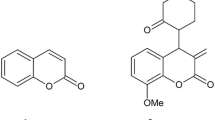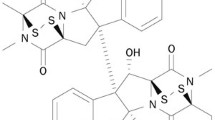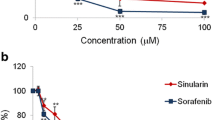Abstract
Widdrol is an odorant compound isolated from Juniperus chinensis. We previously reported that widdrol induces Gap 1 (G1) phase cell cycle arrest and leads to apoptosis in human colon adenocarcinoma HT29 cells. It was also reported that this cell cycle arrest is associated with the induction of checkpoint kinase 2 (Chk2), p53 phosphorylation and cyclin dependent kinase (Cdk) inhibitor p21 expression. In this paper, we investigated the molecular mechanisms of widdrol on the activation of G1 DNA damage checkpoint at early phase when DNA damages occurred in HT29 cells. First of all, we examined that widdrol breaks DNA directly or not. As the results of DNA electrophoresis and formation of phosphorylated histone H2AX (γH2AX) foci in HT29 cells, widdrol generates DNA double-strand breaks directly within 0.5 h both in vitro and in vivo. Based on this result, the change of proteins related in checkpoint pathway was examined over a time course of 0.5–24 h. Treatment of HT29 cells with widdrol elicits the following: (1) phosphorylation of Chk2 and p53, (2) reduction of cell division cycle 25A (Cdc25A) expression, (3) increase of Cdk inhibitor p21 expression, and (4) decrease of the levels of Cdk2 and cyclin E expression in a time-dependent manner. Moreover, only the expression level of mini-chromosome maintenance 4 (MCM4) protein, a subunit of the eukaryotic DNA replicative helicase, is rapidly down-regulated in HT29 cells treated with widdrol over the same time course, but those of the other MCM proteins are unchanged. Overall, our results indicated that widdrol breaks DNA directly in HT29 cells, and this DNA damage results in checkpoint activation via Chk2–p53–Cdc25A–p21–MCM4 pathway and finally cells go to G1-phase cell cycle arrest and apoptosis.






Similar content being viewed by others
References
Sherr CJ (2000) The pezcoller lecture: cancer cell cycles revisited. Cancer Res 60:3689–3695
Sherr CJ, Roberts JM (2004) Living with or without cyclins and cyclin-dependent kinases. Genes Dev 18:2699–2711
Khanna KK, Jackson SP (2001) DNA double-strand breaks: signaling, repair and the cancer connection. Nat Genet 27:247–254
Dotto GP (2000) p21WAF1=Cip1 : more than a break to the cell cycle? Biochim Biophys Acta 1471:43–56
Forsburg SL (2004) Eukaryotic MCM proteins: beyond replication initiation. Microbiol Mol Biol Rev 68:109–131
Liang DT, Hodson JA, Forsburg SL (1999) Reduced dosage of a single fission yeast MCM protein causes genetic instability and S phase delay. J Cell Sci 112:559–567
Cortez D, Glick G, Elledge SJ (2004) Mini-chromosome maintenance proteins are direct targets of the ATM and ATR checkpoint kinases. Proc Natl Acad Sci USA 101:10078–10083
Ishimi Y, Kohno YK, Kwon HJ, Yamada K, Nakanishi M (2003) Identification of MCM4 as a target of the DNA replication block checkpoint system. J Biol Chem 278:24644–24650
Schories B, Engel K, Dörken B, Gossen M, Bommert K (2004) Characterization of apoptosis-induced Mcm3 and Cdc6 cleavage reveals a proapoptotic effect for one Mcm3 fragment. Cell Death Differ 11:940–942
Feng D, Tu Z, Wu W, Liang C (2003) Inhibiting the expression of DNA replication-initiation proteins induces apoptosis in human cancer cells. Cancer Res 63:7356–7364
Kwon HJ, Hong YK, Park C, Choi YH, Yun HJ, Lee EW, Kim BW (2010) Widdrol induces cell cycle arrest, associated with MCM down-regulation, in human colon adenocarcinoma cells. Cancer Lett 290:96–103
Giono LE, Manfredi JJ (2006) The p53 tumor suppressor participates in multiple cell cycle checkpoints. J Cell Physiol 209:13–20
Matsuoka S, Huang M, Elledge SJ (1998) Linkage of ATM to cell cycle regulation by the Chk2 protein kinase. Science 282:1893–1897
Kwon HJ, Lee EW, Hong YK, Yun HJ, Kim BW (2010) Widdrol from Juniperus chinensis induces apoptosis in human colon adenocarcinoma HT29 cells. Biotechnol Bioprocess Eng 15:167–172
Zhou C, Li Z, Diao H, Yu Y, Zhu W, Dai Y, Chen FF, Yang J (2006) DNA damage evaluated by γH2AX foci formation by a selective group of chemical/physical stressors. Mutat Res 604:8–18
Riches LC, Lynch AM, Gooderham NJ (2008) Early events in the mammalian response to DNA double-strand breaks. Mutagenesis 23(5):331–339
Yuan J, Adamski R, Chen J (2010) Focus on histone variant H2AX: To be or not to be. FEBS Lett 584:3717–3724
Bartek J, Lukas J (2001) Mammalian G1- and S-phase checkpoints in response to DNA damage. Curr Opin Cell Biol 13:738–747
Brugarolas J, Moberg K, Boyd SD, Taya Y, Jacks T, Lees JA (1999) Inhibition of cyclin-dependent kinase 2 by p21 is necessary for retinoblastoma protein-mediated G1 arrest after γ-irradiation. Proc Natl Acad Sci USA 96:1002–1007
Dasika GK, Lin SC, Zhao S, Sung P, Tomkinson A, Lee EY (1999) DNA damage-induced cell cycle checkpoints and DNA strand break repair in development and tumorigenesis. Oncogene 18:7883–7899
Yang J, Yu Y, Hamrick HE, Duerksen-Hughes PJ (2003) ATM, ATR and DNA-PK: initiators of the cellular genotoxic stress responses. Carcinogenesis 24:1571–1580
Delia D, Fontanella E, Ferrario C, Chessa L, Mizutani S (2003) DNA damage-induced cell-cycle phase regulation of p53 and p21waf1 in normal and ATM-defective cells. Oncogene 22:7866–7869
Costanzi-Strauss E, Strauss BE, Naviaux RK, Haas M (1998) Restoration of growth arrest by p16INK4, p21WAF1, pRB, and p53 is dependent on the integrity of the endogenous cell-cycle control pathways in human glioblastoma cell lines. Exp Cell Res 238:51–62
Sørensen CS, Syljuasen RG, Falck J, Schroeder T, Ronnstrand L, Khanna KK, Zhou BB, Bartek J, Lukas J (2003) Chk1 regulates the S phase checkpoint by coupling the physiological turnover and ionizing radiation-induced accelerated proteolysis of Cdc25A. Cancer Cell 3:247–258
Hoffmann I, Draetta G, Karsenti E (1994) Activation of the phosphatase activity of human cdc25A by a cdk2-cyclin E dependent phosphorylation at the G1/S transition. EMBO J 13:4302–4310
Molinari M, Mercurio C, Dominguez J, Goubin F, Draetta GF (2000) Human Cdc25 A inactivation in response to S phase inhibition and its role in preventing premature mitosis. EMBO Rep 1:71–79
Costanzo V, Robertson K, Ying CY, Kim E, Avvedimento E, Gottesman M, Grieco D, Gautier J (2000) Reconstitution of an ATM-dependent checkpoint that inhibits chromosomal DNA replication following DNA damage. Mol Cell 6:649–659
Braun KA, Breeden LL (2007) Nascent transcription of MCM2–7 is important for nuclear localization of the mini-chromosome maintenance complex in G1. Mol Biol Cell 18:1447–1456
Acknowledgments
This work was supported by the National Research Foundation of Korea (NRF) grant funded by the Korea government (MEST) (No.2010-0004993) and Blue-Bio Industry Regional Innovation Center (RIC08-06-07) at Dongeui University as a RIC program of KIAT under Ministry of Knowledge Economy.
Author information
Authors and Affiliations
Corresponding author
Rights and permissions
About this article
Cite this article
Yun, H.J., Hyun, S.K., Park, J.H. et al. Widdrol activates DNA damage checkpoint through the signaling Chk2–p53–Cdc25A–p21–MCM4 pathway in HT29 cells. Mol Cell Biochem 363, 281–289 (2012). https://doi.org/10.1007/s11010-011-1180-z
Received:
Accepted:
Published:
Issue Date:
DOI: https://doi.org/10.1007/s11010-011-1180-z




